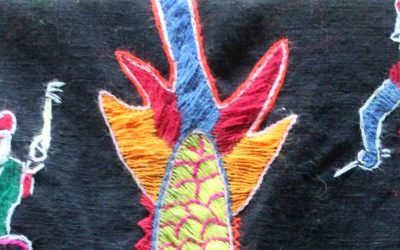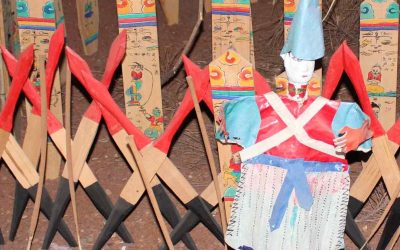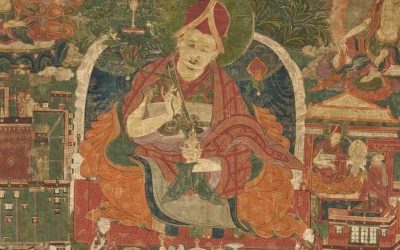The Monastery of Sera – History and foundation
Sera Monastery, located on the outskirts of Lhasa, is one of the largest monasteries in Tibet, and one of the most important centers of learning. Still today many young Tibetans come to the monastery to be trained in the mysteries of Tibetan philosophy and religion, and on visits to this monastery, included in most tours, it is normal to have the opportunity to see monks discussing aspects of doctrine, or some of the printing press rooms that once made this center of learning famous.
Here we have selected part of the article that the Hindu Tibetologist Sarad Chandra Das wrote in 1905 about the monasteries of Tibet (Journal of the Asiatic Society of Bengal.).
The monastery of Sera (literally, wild rose) was founded by Cham-chen-choije Sakya Yeceg in 1418, the year of Tsongkhapa’s death.
The Governor Nehu-pa who patronized Tsongkhapa and his disciples frequently used to invite them to Sera-tse, a retired hermitage on the top of the hill overhanging Sera. On these occasions, Choije devotedly served the reformer, in consequence of which Tsongkhapa predicted a great future for a monastery which Choije would found in that neighbourhood. A saintly Lama while sitting in meditation, cast his eyes on a spot lower down the hermitage which was filled with wild rose plants in blossom. He predicted that someday there would be a monastery there.
Visit to Beijing
Emperor Yongle of the Ming dynasty had sent an invitation to Tsongkhapa to visit Peking; but the great reformer, finding Choije’s time fully occupied with the more important work of religious reformation, sent Cakya Yeces as his representative. Yongle did honour to the Yellow-cap Church by showing every consideration to this disciple of the reformer on his arrival at Peking where Choige’s first act was to bring about the recovery of the Emperor from a serious illness by the efficacy of his religious services. The temple of Maitreya, then recently built by the Emperor, was placed in his charge and he was given the name of Chyam-chen Choije. Under the Imperial auspices, Choije founded the monastery of Hwang-si (Yellow-temple) in one of the imperial gardens of Peking situated a few miles to its north. For diffusing the reformed creed of Tsongkhapa in China he had taken with him several of Tsongkhapa’s works and a set of block-print Kahgyar [113] scriptures. After converting the Lamas of Peking to the reformed Yellow-cap Church he returned to Tibet. On the way, he paid his reverence to Tsongkhapa making rich presents to him. Subsequently, he founded the monastery of Sera Theg-chen-ling, which now contains 5,500 monks and exercises much influence in the secular and religious administration of the country.
Sera University
He established a university in it with four Tva-tshang or colleges. Of these Gya-Tva-tshang belonged to the upper division of Sera and the remaining three, i.e., Thoisam, Norpuiling, Chyipa Khamang Tva-tshang, and Nag-pa Tra-tshang belonged to Sera Mah, (sma) z.e., lower division of Sera. In the middle of the eighteenth century, two of the colleges were established. It still continues to be a favourite resort of learned men of Tibet and Mongolia. The monks of Sera belong to respectable families of Tibet proper, Amdo, Kham, Nyagrong, Mongolia, and Western China.
Main art treasures
There are in the Dukhang (grand hall of the congregation) the images of —
- Buddha vanquishing Mara the evil one and a host of demons.
- The sixteen Sthavira (Neh-tan Chu-rig!) brought from China.
- Several life-like images constructed by the famous artist Nehu Chang-wa.
In the Gonkhang (the temple assigned to the Tantrik deities) there are—
- The image of the six-armed Bhairava, constructed by Leg-an of Shwau.
- Gon-po Choigyal with four arms.
- The goddess Paldem Lhamo (Kali) on horseback, her legs being tied by a chain, probably as a punishment for her wicked conduct.
In the front wall, there are painted representations of the invasion of U by the Tsang army and their defeat by the Tartars in 1643, the scenes of war, and the images of fearful spirits, such as Gon-po De-mar, the genius (Chyarog-dong-chan, he with a raven’s head), etc. On the western wall are painted the likenesses of the successive high priests of Sera, etc.
In the western corner of the upper congregation hall (Duk-hang Gong-ma), are the images of Amitabha Buddha, the eleven-armed Avalokitesvara and the four-armed Gon-po, Maitreya made of silver, the Bodhisattva (Cakya) as a citizen, and the eight spiritual sons of Buddha and also the Kah-gyur and Tangyur collections, all written in gold and silver.
In the temple of Chyam-chen Shal-reh Lhakhang, the image of Atisha with a Chintamani wishing-gem in his hand is conspicuous.
In the Go-chye-khang there are images of Buddha and a silver Chorten. In the further niché of the Dukhang there is a golden image of the coming Buddha. In the front hall of the ukhang there are the Dharma Pala. The most remarkable object in the passage of circumambulation round the monastery is a small Chattya (said to be one of the 84,000 chattya constructed by Emperor Asoka) which was brought from Magadha. There is also a Tantrik image of Hayagriba with the goddess Vajra Varéhi in his clasp.
Last posts
Thoughts about the Yao history
Thoughts about the Yao history Two of the papers presented in the First International Congress of Yao Studies deal with the origin and meaning of the "King Ping's Charter", a kind of document that granted the Yao free pass across the mountains of the 15 southern...
History of the Yao of China
History of the Yao of China The Yao consider that Panhu is their ancestor. A mythical figure placed in the center of their most important myths that had real existence for them. Some of the modern specialists agree that Panhu is, in fact, a mythified local hero, which...
Interpretation of dreams among the Yao
Interpretation of dreams among the Yao The Yao have a complex system of dream interpretation, which, like other neighboring peoples, they divide into auspicious and unfortunate. For them, to dream of the sun setting behind a hill announced a calamity upon the parents....
The monasteries of Tibet- the soul of the land
The monasteries of Tibet- the soul of the land One of the most charismatic aspects of Tibetan culture is its monasteries. Mention Tibet to anyone, at least in the West, and they will immediately associate that word with the monasteries and their monks. Those...
The Llubhu, women shamans of the Naxi
The Llubhu, women shamans of the Naxi The llubhu (also called sunyi) are the Naxi sorcerers or sorceresses. In ancient days they were always women, mediums who went into trances and claimed to see ghosts, the spirit of the deceased persons. They have the power of...
Sakya Monastery and its impressive art treasures
Sakya Monastery and its impressive art treasures Sakya Monastery is located 165 kilometers west of Shigatse, on the road to Tingri, and is a must-see for all travelers who can spare a little time to explore central Tibet, as well as those who end (or begin their...










